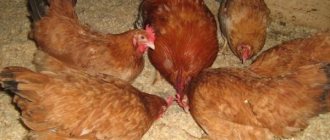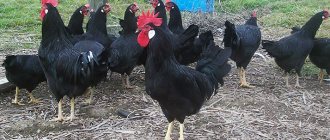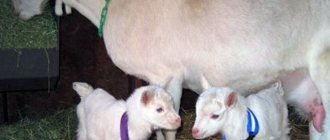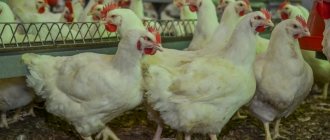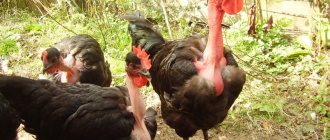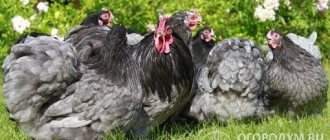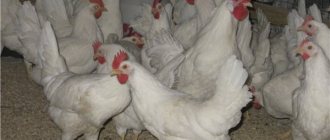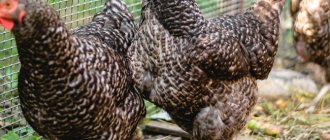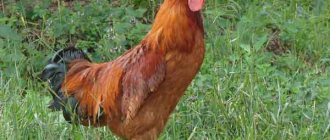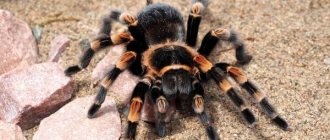Description and characteristics
In countries such as England and France, mini-chickens have already completely replaced broilers, not only because of their own external characteristic properties, but also their calm nature and well-developed maternal instinct.
External features
The body of such chickens, despite their compactness, is very dense and fleshy, with thick plumage, a wide back and a round chest. On the head of a classic size there is a small leaf-shaped crest and small ears.
Video: description of the B-66 chicken breed The paws are short, with a shortened metatarsus (it is 30% smaller than that of other meat breeds). The neck is very large. The wings are rather poorly developed and fit well to the body.
Character
As for the behavior of such chickens, they, unlike other breeds of meat poultry, are quite calm, do not fight with neighbors, except for rare skirmishes between roosters, and, which is very important for farmers, do not dig holes.
Hatching instinct
The incubation instinct of the breed in question is very well developed, so there is absolutely no need to force the hens to sit on eggs. Their desire to sit eggs arises in the spring, when the period of vigorous egg production begins. The duration of incubation is from 21 to 24 days.
History of the breed
Together with other popular breeds of mini-chickens, which are now widespread in Europe, the B-66 was bred at the All-Russian Research Veterinary Institute of Poultry Farming. There are three main colors of representatives of this breed: fawn, white and red-black.
Did you know? Contrary to popular belief that chicken brains are underdeveloped, a one-day-old chick exhibits the same skills and reflexes as a three-year-old child. Moreover, despite the simple structure of the chicken’s brain, these birds are able to distinguish the owner from other people, remember about a hundred faces, easily learn new skills and have excellent time orientation, clearly knowing when the next feeding time will come.
All of them are carriers of the dwarfism gene, isolated through selection and careful breeding from breeds such as Plymouth Rock, Leghorn, Cornish and Rhode Island. The purpose of creating such chickens was to solve economic problems in rural farms.
Efficiency
Despite the fact that chickens of the B-66 breed are very small, they have excellent dynamics and growth intensity. With fairly rapid puberty, they have excellent egg production.
Intensity and dynamics of growth
Chickens of this breed grow quite quickly:
- by the age of 2 months, cockerels weigh approximately one kilogram, and hens weigh 800–850 g;
- at the age of 3 months, males already weigh about 1.7 kg, and females - about 1.5 kg;
- if you keep the chickens in the necessary conditions and give them enough food, after 4 months the cockerels will weigh up to 2.5 kg, and the hens will weigh up to two kilograms;
- at a very mature age, the weight of cockerels can be about three kilograms, and hens - 2.7 kg.
Puberty and egg production
Puberty in individuals occurs at the age of 3 to six months. The egg production of this breed is multi-purpose; one individual can lay 180 eggs during the year, each of which weighs from 50 to 60 g.
Full characteristics of the breed
The first thing a farmer looks for when choosing a breed for breeding is its productivity.
View 66 has the following characteristics:
- the average egg production is 180 eggs per individual, but many breeders claim that with proper care and feeding you can achieve 260 eggs per year;
- Compact build;
- the metatarsus is shortened;
- individuals are ready for mating at 24 weeks of life;
- the weight of adult males ranges from 2.7 to 3.2 kilograms;
- chickens weigh from 2.5 to 2.7 kilograms;
- at three months the individual weighs 1350-1600 grams;
- egg weight from 50 to 65 grams;
- high egg fertilization rate 93%;
- the survival rate of young animals is also high, on average 85-87%, but breeders who are already breeding this breed claim that with proper care, 95-98% can be achieved;
- thanks to its miniature size, planting density can be reduced by 40%;
- savings in feed are 35-40%; for one individual, 120 grams of food per day is enough;
- The bird feels comfortable in cage conditions, but floor-based housing can also be arranged.
Based on these productivity indicators, we can safely conclude that this type of chicken is very beneficial for agriculture. They are easy to breed in home farms. After all, the conditions of the chicken coop and temperature conditions are the same as for ordinary chickens. The birds are fed standard compound feed, grains and legumes, wet mash, herbs, and so on.
Feeding ration
The B-66 chicken breed is undemanding in terms of feeding, but it is important to know what differences are present in the diet of large individuals that are raised to lay eggs, and young representatives of the breed, left for meat.
Adult herd
It is better to feed individuals raised for hatching eggs at a young age with compound feed (120–130 g per day per individual), after which they are gradually transferred to crushed grain mixtures with the indispensable use of grass, wet food, meat-and-bone meal and other additives.
In order to get excellent chicken meat in a short time, it is important not to skimp on feed, but to use a high-quality factory product with a high content of amino acids, minerals and vitamins that growing birds need so much.
Other dwarf varieties
Hamburg
A meat-and-egg breed of dwarf chickens, the distinctive feature of which is their bright and original plumage.
The body and neck are elongated, the head is small, which gives the birds grace. The birds are distinguished by a wide back and chest, a rose-shaped crest, and slender legs covered with feathers down to the shins.
The color of the feathers is unique, so Hamburg chickens are often used as ornamental birds. There are silver-white, black, golden-black shades. The plumage pattern can be speckled or striped.
Hamburg mini-hens begin laying eggs at 5 months, but do not hatch offspring. Up to 180 eggs are laid per year, and the time of year does not affect egg production. Even in winter, the birds feel good, provided that the chicken coop is equipped with additional lighting.
Dwarf Leghorn B 33
Dwarf Leghorns are an egg breed of mini chickens with cockerels weighing up to 1.7 kg and hens weighing about 1.4 kg.
The breed differs in that laying hens are capable of laying fairly large eggs already at 4 months. Find the rest of the information in the article “About the Dwarf Leghorn B 33”.
Bantams
The weight of an adult bantam reaches no more than 1 kg. The birds have colorful plumage, a low body, a small head, but wide, long wings that often reach the ground. These mini chickens are resistant to various infections and other diseases.
The breed has many varieties with different types: egg, meat, fighting and decorative. Egg production varies depending on the direction. On average, chickens produce 90-130 eggs per year, weighing about 45 g.
Laying hens are able to lay eggs and hatch eggs for 4 years. Chickens have tender meat that tastes like partridge.
Dwarf Cochin
Mini Cochins have a massive body and a good-natured disposition. Read more about this breed in the article “Dwarf Cochin Chickens.”
Wyandotte
The distinctive characteristics of the breed are lush and bright plumage, a small tail, and short wings. Each feather of the bird has an original color border.
The first eggs are given already at 6-7 months of life. Egg production is about 180 eggs per year, 65 g each. Hens can weigh up to 3 kg, the weight of cockerels reaches 3.8 kg.
Dwarf Dutch White-crested
This breed owes its name to the large white crests that flow down on both sides of the birds’ heads. There is no crest, and the metatarsus are bright and large, especially in roosters. The body is elongated and compactly folded. Color can be black, brown and blue-gray.
The weight of the cockerel is 2.5 kg, the hen – 2 kg. White-crested hens are capable of producing about 140 eggs per year, weighing 40-50 g, with a white shell. Chickens begin to lay eggs at the age of six months and breed offspring well.
Dwarf gate
This is one of the popular chicken breeds among breeders. They are very easy to maintain and their appearance is extremely attractive.
A full description of the breed of mini-meat chickens is given in the article “Breed of Brahma chickens.”
Dwarf Oryol
The Oryol breed of chickens is the oldest in Russia. Its miniature representatives weigh no more than 1 kg. The head is small in size, located on a long neck. There is also an unusually shaped ridge strewn with numerous tubercles.
The character is not the same as that of most dwarf chickens: Oryol chickens are aggressive and pugnacious. Egg products, amounting to 100-110 pieces per year, have good taste.
Shabo
Chabot chickens are extremely hardy, despite the fact that they are miniature birds weighing no more than 600 g for males and 500 g for hens.
The plumage is varied: striped, black-silver, golden, light yellow. They have a short back, a convex chest, a long straight tail, and lush plumage on the neck.
Laying hens have a strong maternal instinct. They are often used to incubate clutches of chickens of other breeds. Annual egg production is 150 eggs, each weighing no more than 30 g.
Seabright
This breed of chicken has a pronounced pattern on wide feathers with rounded ends. Moreover, the color of the plumage is the same in both sexes of the bird.
They have a small head with a curved pink beak, a stocky body with a short back and neck. The weight of a cockerel is 600 g, that of a hen is 500 g. Eggs begin to be laid at 7 months. Despite their small size, 46 gram eggs are considered the most delicious among others.
Small goloshki
The Lesser Roughneck is an unusual bird in appearance, as part of the plumage on its neck is missing. They can easily tolerate heat, but they also feel good in winter.
The weight of hens reaches 700 g, cockerels - 800 g. They are distinguished by good egg production - up to 120 eggs of 30 g each per year.
Millefleur
Chickens of this breed have a small, neat body with dense, bright and unusual plumage.
Other characteristics are presented in the article “Description of the millefleur chicken breed.”
Dwarf Welsumer
The birds are small in size with a low body and a long, narrow back. The tail is located at an obtuse angle relative to the body.
They are popular among breeders due to their egg production - more than 130 eggs per year. But laying hens of this breed do not have the instinct to hatch, so for breeding and updating the parent flock it is necessary to purchase an incubator.
Pygmy phoenix
Mini chickens of this breed are slender and graceful birds with an upright body and a long tail. Its length varies from 1.5 to 3 meters.
The breed standard provides for several plumage colors: wild, orange, white, silver-maned and golden-maned.
The weight of the rooster is 0.8 kg, the hen - 0.7 kg. The eggs have a yellowish shell and weigh 25 g. The hen lays 60 eggs per year.
Dwarf New England
This is a fighting breed of chickens. Also called “modern” in another way.
An adult rooster weighs 2.5 kg; he zealously defends the flock and territory, even from breeders. Chickens weigh 1.8 kg.
Small English fighting dog
Chickens of this breed are distinguished by a strong physique and good physical characteristics.
Roosters have broad shoulders and a body that converges toward the tail in the form of a wedge. As well as a flat, short tail and high-set wings. The weight of a rooster is 2-3 kg, a chicken – up to 2 kg.
Dear poultry farmers, have you ever dealt with the listed breeds of mini chickens? Share your observations in the comments, invite your friends to discuss the topic by reposting. We will be grateful for 5 stars.
Content Characteristics
Proper maintenance is the key to the health and productivity of chickens, the quality of their eggs and meat. Because of this, it is necessary to remember how to take good care of the poultry house or cages in which the birds live, and also to fulfill the conditions for their comfortable living.
In the poultry house
Keeping birds in a chicken coop requires following specific rules:
- The poultry house for these chickens may not be high enough, because its inhabitants themselves do not stand out for their large size.
It does not need to be equipped with heating devices, because this breed adapts perfectly to any climate conditions. However, on the first day of life, the chicks should be provided with warmth, because the cold can kill them.
Individuals raised for meat production are best kept in cages. Mandatory actions for caring for cages are practically no different from what needs to be done to maintain cleanliness in the poultry house: you should disinfect the cages with antiseptic solutions, constantly change the litter, carry out general cleaning, etc.
But, in the case of cages, this needs to be done much more often than in poultry houses. At the same time, you need to remember that birds need walks in clean air, where they can get healthy vitamins for themselves, so it is important, especially in the warm season, to constantly let chickens go for a walk.
How to breed the breed?
If in the future the farmer wants to sell eggs for incubation or chickens, then special attention should be given to breeding individuals. After two months of life, it is necessary to select the strongest cockerels and hens that best meet the stated breed standards. It is strictly forbidden to allow the addition of other blood, because in the future new individuals will not be able to pass on their qualities.
The declared breed has only a white color, but it can be changed or diluted by crossing individuals of the “Vnitip” line with p 11, b 77, b 33, and so on. It is necessary to add a purebred cockerel of a different color, and as a result you can get a fawn, striped or red color.
When crossing, adding fresh blood is not recommended. Due to this, birds' immunity can be significantly reduced and hereditary traits can subsequently be lost.
These chickens are also used to produce high productivity broilers. Females are mated with meat-producing roosters, such as the Cornish breed.
Mini chickens develop and grow very well. They also love warmth, so for the first days after birth, they need to be kept under lamps. In order for the survival rate to be high, it is necessary to organize good feeding, cleanliness, as well as inspect the young animals and remove weak or sick individuals in a timely manner. It is also necessary to prevent overcrowding of the young, because of this reason, chickens mainly die.
Advantages and disadvantages
Among the main positive qualities of chickens of the B-66 breed, it is necessary to note:
- early puberty, which allows such birds to begin laying eggs at the age of 3 months;
- high growth rate;
- a traditional diet that does not differ in any way from the feeding possibilities of other types of chickens;
- ease of maintenance: these mini-chickens do not need large cages;
- birds lay very large eggs, not paying attention to their small size;
- their maintenance does not require large expenses, because for normal growth and development birds of this breed require much less feed than ordinary large domestic chickens;
- representatives of this breed have a moderate character and are not predisposed to aggression;
- They have good immunity, resistant to common avian diseases.
Chickens of the B-66 breed have few disadvantages, as well as good qualities, but they still exist:
- if you have got mini-chickens of different colors, they need to be kept separately, because you cannot cross breed chickens of different colors;
- It is better not to let such birds go outside in cloudy weather: due to their short legs, their bellies touch puddles, get wet and can get sick.
Mini-chickens of the B-66 breed will certainly meet the expectations of owners who purchase them to produce good meat and hatch eggs.
Such birds do not consume a lot of food, do not require special care, and have a moderate character, which is very comfortable for both small farms and larger poultry farming.
Correct content is the key to success!
No poultry will show good productivity if it is kept in poor conditions and fed incorrectly. Also, for mini chickens, you must follow several rules of care. The first thing is the cleanliness of the chicken coop. It is necessary to regularly remove droppings and wash feeders and drinking bowls daily. If wet food is given, which is typical for breeding at home, then feed should be provided as much as the chickens can eat at one time. Because mash oxidizes quickly. There should be no drafts in the room. The normal temperature for keeping is 18-25 degrees. Cleanliness is very important for mini chickens. If the owner takes good care of his livestock, he avoids many intestinal diseases, parasites and other ailments. Basically, all diseases of chickens appear due to unsanitary conditions and a poor diet.
When keeping cells in cages, it is necessary to treat the cells with special antiseptic solutions, and cleaning must be done more often than with floor breeding. When feeding, it is best to focus on compound feed, which is intended for meat birds.
